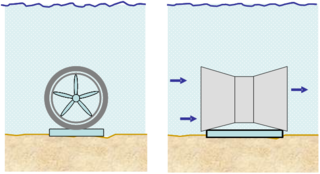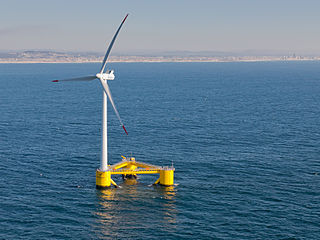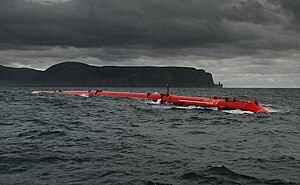
Tidal power or tidal energy is harnessed by converting energy from tides into useful forms of power, mainly electricity using various methods.
Wave Dragon is a concept wave energy converter of the overtopping type, developed by the Danish company Wave Dragon Aps. Incoming waves flow up a ramp into a reservoir, the water the drains back to sea level though a hydro-electric turbine, generating electricity. "Reflector arms" are used to focus incoming waves, to channel the waves towards the ramp, increasing the energy captured.

The Pelamis Wave Energy Converter was a technology that used the motion of ocean surface waves to create electricity. The machine was made up of connected sections which flex and bend as waves pass; it is this motion which is used to generate electricity.

The production of renewable energy in Scotland is a topic that came to the fore in technical, economic, and political terms during the opening years of the 21st century. The natural resource base for renewable energy is high by European, and even global standards, with the most important potential sources being wind, wave, and tide. Renewables generate almost all of Scotland's electricity, mostly from the country's wind power.

Renewable energy in the United Kingdom contributes to production for electricity, heat, and transport.
Pelamis Wave Power designed and manufactured the Pelamis Wave Energy Converter – a technology that uses the motion of ocean surface waves to create electricity. The company was established in 1998 and had offices and fabrication facilities in Leith Docks, Edinburgh, Scotland. It went into administration in November 2014.
The Oyster was a hydro-electric wave energy device that used the motion of ocean waves to generate electricity. It was made up of a Power Connector Frame (PCF), which is bolted to the seabed, and a Power Capture Unit (PCU). The PCU is a hinged buoyant flap that moves back and forth with movement of the waves. The movement of the flap drives two hydraulic pistons that feed high-pressured water to an onshore hydro-electric turbine, which drives a generator to make electricity. Oyster was stationed at the European Marine Energy Centre (EMEC) at its Billia Croo site in Orkney, Scotland until the company ceased trading in 2015.

A tidal farm is a group of tidal stream generators used for production of electric power. The potential of tidal farms is limited by the number of suitable sites across the globe as there are niche requirements to make a tidal farm cost effective and environmentally conscious.

A tidal stream generator, often referred to as a tidal energy converter (TEC), is a machine that extracts energy from moving masses of water, in particular tides, although the term is often used in reference to machines designed to extract energy from the run of a river or tidal estuarine sites. Certain types of these machines function very much like underwater wind turbines and are thus often referred to as tidal turbines. They were first conceived in the 1970s during the oil crisis.
The Aegir wave farm was a planned wave farm off the south west of Shetland. The project was developed by Aegir Wave Power, a 2009 formed joint venture of Vattenfall and the wave power technology developer Pelamis Wave Power. The wave farm would have had capacity from 10 MW potentially up to 100 MW. Following the collapse of Pelamis in November 2014, the project was cancelled by Vattenfall in February 2015.

Orbital Marine Power is a Scottish renewable energy company focused on the development and global deployment of its pioneering floating turbine technology. The O2 is Orbital's first commercial turbine and represents the culmination of more than 15 years of world leading product development in the UK. The 74 m long turbine is expected to operate in the waters off Orkney for the next 15–20 years with the capacity to meet the annual electricity demand of around 2,000 UK homes with clean, predictable power from the fast-flowing waters while offsetting approximately 2,200 tonnes of CO2 production per year. In a further ground-breaking element of the project, the O2 will provide power to the European Marine Energy Centre's onshore electrolyser to generate green hydrogen that will be used to demonstrate decarbonisation of wider energy requirements.
Mocean EnergyLtd. is a wave energy technology developer, based in Edinburgh and Aberdeen. They are developing a hinged-raft attenuator wave energy converter (WEC) at various scales for different markets.
Many tidal stream generators have been developed over the years to harness the power of tidal currents flowing around coastlines. These are also called tidal stream turbines (TST), tidal energy converters (TEC), or marine hydro-kinetic (MHK) generation. These turbines operate on a similar principle to wind turbines, but are designed to work in a fluid approximately 800 times more dense than air which is moving at a slower velocity. Note that tidal barrages or lagoons operate on a different principle, generating power by impounding the rising and falling tide.

OpenHydro Group Ltd was an Irish developer of tidal stream turbines, established in 2004. It was acquired by Naval Energies in 2013, however, Naval Energies decided in July 2018 to stop developing tidal turbines and focus on floating wind turbines. The company subsequently went into liquidation with debts of about €280m.
Minesto AB is a Swedish developer of electricity producing tidal kite turbines, based in Gothenburg. They also have a manufacturing base in Holyhead, North Wales, and a test facility at Portaferry, Northern Ireland.
CorPower Ocean AB is a wave energy device developer, headquartered in Stockholm, Sweden. They also have offices in Oslo, Viana do Castelo, and Stromness. The office in Viana do Castelo is an R&D centre that also serves as the manufacturing and service centre for the wave energy converters (WEC).

The Aguçadoura test site is an offshore location in the north of Portugal where grid connected offshore renewable energy devices have been tested, for research and project demonstration. It is about 5 km (3 miles) off the coast of Aguçadoura, Póvoa de Varzim, about 35 km NNE of central Porto.

The Penguin is a wave energy converter (WEC) which was developed by Finnish company Wello Oy between 2008 and 2023. Two full-scale device were constructed, and tested in Scotland and Spain respectively, although both tests ended in difficulties.
Magallanes Renovables, S.L. is a Spanish developer of floating tidal stream energy devices, set up in 2009. The company's head office is in Redondela, Galicia, with a UK subsidiary Magallanes Tidal Energy Ltd. based in Kirkwall.















